Caryn

 My nephew, Rob Masterson is my first nephew, and he was a bit of a culture shock for me. Up until Rob came along, we were a family of girls. My parents had five daughters, and other than Rob’s dad, Rob Masterson, we still had girls, because we had my nieces, Chantel Balcerzak and Toni Chase…and then came Rob. As we all know…especially all women…men are inherently different. While men can usually mature their way out of it to a degree, little boys…oh boy!! If I had grown up around brothers, I might have been more prepared for my nephew, but I had basically no experience in boys. Even the babysitting jobs I had were girls. Girls were my whole life-experience up to that time. To further complicate things, I had two daughters. Girls were the way of life in the Spencer family. My younger sisters each did have one boy among their multiple girls, so we were further educated in the ways of little boys, and I think it was a good thing that Rob prepared me for boy life, because my girls together had three boys and one girl, and the trend of mostly boys is continuing in the great grandkids too. So, thanks for giving me the education in the ways of little boys, Rob. I think I needed it.
My nephew, Rob Masterson is my first nephew, and he was a bit of a culture shock for me. Up until Rob came along, we were a family of girls. My parents had five daughters, and other than Rob’s dad, Rob Masterson, we still had girls, because we had my nieces, Chantel Balcerzak and Toni Chase…and then came Rob. As we all know…especially all women…men are inherently different. While men can usually mature their way out of it to a degree, little boys…oh boy!! If I had grown up around brothers, I might have been more prepared for my nephew, but I had basically no experience in boys. Even the babysitting jobs I had were girls. Girls were my whole life-experience up to that time. To further complicate things, I had two daughters. Girls were the way of life in the Spencer family. My younger sisters each did have one boy among their multiple girls, so we were further educated in the ways of little boys, and I think it was a good thing that Rob prepared me for boy life, because my girls together had three boys and one girl, and the trend of mostly boys is continuing in the great grandkids too. So, thanks for giving me the education in the ways of little boys, Rob. I think I needed it.
These days, Rob is a great husband and dad. He has three daughters, Christina Masterson, Raelynn Masterson, and Audrianna Masterson, and one son, Matthew Masterson. He and his wife, Dustie Masterson are both supervisors, he at Sam’s Club’s tire and automotive department, and Dustie at Walgreen’s. Life is good, and they are very happy. They have been married now almost 20 years, and each year gets better and better. They love their jobs, their lives, and each other. They are soulmates, and I can’t imagine one without the other.

 Being a supervisor is a job with a lot of responsibility. With that, often comes many hours on the job. That makes for not seeing Rob and Dustie very much. In fact, if we want to see them, the best place to do that is at their place of work. Of course, that isn’t the best place for any kind of a real conversation, so mostly we end up waving and saying, “Hello.” It’s ok, because we are family, and we all know we love each other, even if we are usually too busy for a long visit. The main thing really is that they are able to usually make time to go see my sister, Cheryl Masterson, Rob’s mom, because after all, they are her kids, and she needs to be able to see them as often as possible. They are a close family, and they make it work. Today is Rob’s birthday. Happy birthday Rob!! Have a great day!! We love you!!
Being a supervisor is a job with a lot of responsibility. With that, often comes many hours on the job. That makes for not seeing Rob and Dustie very much. In fact, if we want to see them, the best place to do that is at their place of work. Of course, that isn’t the best place for any kind of a real conversation, so mostly we end up waving and saying, “Hello.” It’s ok, because we are family, and we all know we love each other, even if we are usually too busy for a long visit. The main thing really is that they are able to usually make time to go see my sister, Cheryl Masterson, Rob’s mom, because after all, they are her kids, and she needs to be able to see them as often as possible. They are a close family, and they make it work. Today is Rob’s birthday. Happy birthday Rob!! Have a great day!! We love you!!

 My sister, Caryl Reed is my junior by three years, but since we are both grown up, the years really don’t make much difference. It’s the same with all my sisters really. We are all like-minded…the products of the good upbringing of our parents, Al and Collene Spencer. While our parents are in Heaven now, I think they would be very proud of their “prayer warrior” daughters. Our parents raised us to be believing Christians, and in these turbulent times, I can’t imagine living without God’s leading in my life. I know my sisters feel the same way.
My sister, Caryl Reed is my junior by three years, but since we are both grown up, the years really don’t make much difference. It’s the same with all my sisters really. We are all like-minded…the products of the good upbringing of our parents, Al and Collene Spencer. While our parents are in Heaven now, I think they would be very proud of their “prayer warrior” daughters. Our parents raised us to be believing Christians, and in these turbulent times, I can’t imagine living without God’s leading in my life. I know my sisters feel the same way.
Caryl currently lives in Rawlins, for a few more months. Then she and her husband Mike Reed will begin their new life on “the ranch” outside Casper. They have been working very hard to get their beautiful ranch up and running. They had a home built there, as well as a “barn” with a huge garage area to store their farming equipment in and a recreation/trophy room to house the trophies from Mike’s hunting trips. There is also an apartment above the “barn” which can be rented out or used as a guest house if needed. They have had their first two crops of hay already, and these were both sold to their neighbor, who was so excited to buy locally and 
 very close to home. All in all, “the ranch” has been a very successful “side gig” for them.
very close to home. All in all, “the ranch” has been a very successful “side gig” for them.
Of course, the “side gig” part of the ranch isn’t the main reason they bought the ranch. Caryl and Mike love the atmosphere of the ranch. It is far enough outside of town to be quiet and peaceful. The views from their windows, especially from the dining room are simply stunning. Being there is the single most relaxing part of their lives today…as well as the most work, because on a working ranch, sitting for hours admiring the view of the mountains isn’t really an option for very long. Caryl and Mike are always improving the place. They basically built everything from scratch. There was a small house…that their friend and ranch hand lives in; and birthing buildings…that had to be torn down. Other than that, the ranch was raw land. Now is it beautiful, and a wonderful home for them.

 Caryl has always been a country girl at heart. I lived in the country for about 20 years, but I can’t say that I was a country girl. As my sister, Alena Stevens once said, “You are a city girl. You just sleep in the country.” Hahahahaha!! So true, Alena. So true. Caryl, however, really always wanted to live on a ranch, with horses, and possibly a number of other animals, especially dogs. Caryl has always embraced everything country, and very soon, she will be living there full time. Today is Caryl’s birthday. Happy birthday Caryl!! Have a great day!! We love you!!
Caryl has always been a country girl at heart. I lived in the country for about 20 years, but I can’t say that I was a country girl. As my sister, Alena Stevens once said, “You are a city girl. You just sleep in the country.” Hahahahaha!! So true, Alena. So true. Caryl, however, really always wanted to live on a ranch, with horses, and possibly a number of other animals, especially dogs. Caryl has always embraced everything country, and very soon, she will be living there full time. Today is Caryl’s birthday. Happy birthday Caryl!! Have a great day!! We love you!!

 My brother-in-law, Mike Stevens is heading for some very big life changes. He and my sister, Alena Stevens are getting ready to welcome a new granddaughter on June 24th, and they are so excited to meet her. They don’t know their new little sweetheart’s name yet, but since she will arrive by C-section, they know when she will arrive. The whole family is very excited. With their son, Garrett and his family living in Sheridan, it has been harder for them to see their oldest granddaughter, Elliott, but all that is about to change.
My brother-in-law, Mike Stevens is heading for some very big life changes. He and my sister, Alena Stevens are getting ready to welcome a new granddaughter on June 24th, and they are so excited to meet her. They don’t know their new little sweetheart’s name yet, but since she will arrive by C-section, they know when she will arrive. The whole family is very excited. With their son, Garrett and his family living in Sheridan, it has been harder for them to see their oldest granddaughter, Elliott, but all that is about to change.
On July 1st, Mike is going to retire from the oil fields, after 39 years. It has been a long and successful career, in which Mike has been promoted to high levels, and has had great success. Still, the time comes for all of us to retire and enjoy our golden years, even though the definition 
 of those years has really changed for most people. It used to be that when people retired, they sat around watching television and sleeping in their chair, but these days people are really quite active. While our hobbies and activities of choice are different, they usually keep us very busy.
of those years has really changed for most people. It used to be that when people retired, they sat around watching television and sleeping in their chair, but these days people are really quite active. While our hobbies and activities of choice are different, they usually keep us very busy.
Mike and Alena are no exception to that rule. They have plans to do a lot of golfing, camping, and possibly some traveling with Mike’s new-found free time. In the immediate future, they plan to be in Sheridan to help out with Elliott while her parents are in the hospital with Elliott’s new baby sister. They are also hoping to bring Elliott to Casper for several weekends this summer, and before long the new baby will also be coming for visits. Kids love to spend the night with the grandparents, and it’s even more fun when that means a trip to a different town. Elliott and her grandpa are best friends. Mike loves to chase her around the house, push her on the swings, and pull her around on a sheet. Elliott giggles and giggles. They really are pals. The best kind of pals…grandpa and granddaughter kind of pals.

 While Mike is leaving the oil field, the oil field isn’t totally leaving Mike. The convenient thing about the oil field is that they are always in need of oil field consultants, and it can be a really lucrative side gig too. Mike’s 39 years of oil field experience make him a prime candidate for the oil field consultant position, and they work their own hours, taking the jobs they choose, and not the ones they are told to do. I know that Mike will be very successful in all of his post-retirement ventures. Today is Mike’s 63rd birthday. Happy birthday Mike!! Have a great day!! We love you!!
While Mike is leaving the oil field, the oil field isn’t totally leaving Mike. The convenient thing about the oil field is that they are always in need of oil field consultants, and it can be a really lucrative side gig too. Mike’s 39 years of oil field experience make him a prime candidate for the oil field consultant position, and they work their own hours, taking the jobs they choose, and not the ones they are told to do. I know that Mike will be very successful in all of his post-retirement ventures. Today is Mike’s 63rd birthday. Happy birthday Mike!! Have a great day!! We love you!!

 My grandniece, Katy Herr has been living the dream lately…well, for the past several years really. Katy’s life did a complete 180° turn in 2019, when she met her future husband, Dylan Herr. Dylan was different than anyone else Katy had ever known. Dylan was her soulmate. Before Dylan, Katy really felt like life was passing her by. She wanted to be a wife and mother, and none of that was working out.
My grandniece, Katy Herr has been living the dream lately…well, for the past several years really. Katy’s life did a complete 180° turn in 2019, when she met her future husband, Dylan Herr. Dylan was different than anyone else Katy had ever known. Dylan was her soulmate. Before Dylan, Katy really felt like life was passing her by. She wanted to be a wife and mother, and none of that was working out.
Today, Katy is married to Dylan, and they have a beautiful little boy named Max, who is almost two years old. Together, Katy’s men have made her life as close to perfect as it gets. To make life even better, Katy and Dylan recently bought a new house…their first together, and they just couldn’t be happier. They had moved from Brighton, Colorado to Casper, Wyoming to open a new store, Dylan and his family own and operate a number of Red Wing Shoe Stores. They will be stationed here, but Dylan will likely have to travel to the other stores periodically. That said, since they can, Katy and Max will probably go along, so they can all visit with Dylan’s family. Katy and Dylan are also enjoying their roles as community representatives. They are very active in fund raisers and other ways to make our community a better place to live. They rather love the dressing up for date night aspect of all that being community representative entails.
Katy is very much enjoying being a stay-at-home wife and mom, and Max keeps her very busy, as any two-year-old child will do. She also has a beautiful home that she is working on making their own. They also enjoy 
 going to the lake. Katy pretty much grew up around Alcova Lake, because her grandparents, Chip and Trish Burgess had a cabin at the lake. I’m sure that Max will be as much a “fish” as Katy and her brother, Keifer were. Katy and Dylan also love to tour area gardens and parks. Max loves to be outside and to play in the grass and on the swings. The whole family enjoys their time together and with other family members. These days, things are going great for Katy, and I’m sure it will only get better. She has so much life to look forward too. Today is Katy’s birthday. Happy birthday Katy!! Have a great day!! We love you!!
going to the lake. Katy pretty much grew up around Alcova Lake, because her grandparents, Chip and Trish Burgess had a cabin at the lake. I’m sure that Max will be as much a “fish” as Katy and her brother, Keifer were. Katy and Dylan also love to tour area gardens and parks. Max loves to be outside and to play in the grass and on the swings. The whole family enjoys their time together and with other family members. These days, things are going great for Katy, and I’m sure it will only get better. She has so much life to look forward too. Today is Katy’s birthday. Happy birthday Katy!! Have a great day!! We love you!!
 As another year has come and gone, I find myself again saddened that our cousin, Larry Hein is no longer with us. How could it be that he has been in Heaven now for almost a year and a half? Larry was a wonderful son, brother, and dad. He was also a successful businessman in Forsyth, Montana, and many people in town were helped by his mechanical ability and his towing business. Life wasn’t always easy for Larry. He lost his wife to an auto accident and was left to raise his children alone. He did a good job with that, and by the time he went to Heaven, his youngest child, Destiny was almost grown, and his son, Dalton was a grown man. I know they were so sad that he was no longer with them, but they were also grateful that they had him for most of their childhood years.
As another year has come and gone, I find myself again saddened that our cousin, Larry Hein is no longer with us. How could it be that he has been in Heaven now for almost a year and a half? Larry was a wonderful son, brother, and dad. He was also a successful businessman in Forsyth, Montana, and many people in town were helped by his mechanical ability and his towing business. Life wasn’t always easy for Larry. He lost his wife to an auto accident and was left to raise his children alone. He did a good job with that, and by the time he went to Heaven, his youngest child, Destiny was almost grown, and his son, Dalton was a grown man. I know they were so sad that he was no longer with them, but they were also grateful that they had him for most of their childhood years.
I remember Larry as a young boy, because I married his cousin, Bob when Larry was just six years old. He was a good boy, and when my own children, Corrie Petersen and Amy Royce came along, Larry would go out to the playhouse on Grandma and Grandpa Hein’s house, and even though he was a boy, he was willing to playhouse with the girls, because they needed a “daddy” for the “family” game they were playing. While I’m sure Larry was quite bored, he was a good sport, and took it all in stride, even to caring for the baby dolls they were using for the kids.

Larry loved being out at Grandma Hein’s house, as we all did. There was always something to do and everyone had a great time. Grandma and Grandpa made life a big game…even if the kids were actually helping with the chores. And, they learned responsibility and good values, because they really did help around the ranch. They also got to ride the horses and help with the other animals that were being raised. Larry was a good help, as were the other kids, and they were all a blessing to Grandma and Grandpa Hein. Tody would have been Larry’s 53rd birthday. Happy birthday in Heaven, Larry. I know you are all celebrating there. We love and miss you very much.
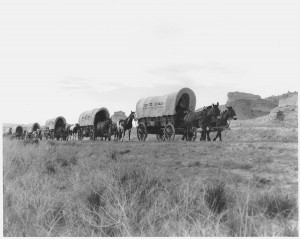
 It was inevitable really…the migration of the people of the United States to the west coast, in search of gold, adventure, and more land. The east was filling up, and there was no place else to go, but west. Of course, many people would either not make it all the way to the West; choosing rather to homestead along the way, die, or actually make it to the West, and then return to the East. Nevertheless, before anyone could find out is life on the west coast suited them or not, they had to get to the west coast, and on May 16, 1842, the first major wagon train to the northwest departed from Elm Grove. Missouri, on the Oregon Trail. This was a little bit of a risky move, because US sovereignty over the Oregon Territory was not clearly established until 1846.
It was inevitable really…the migration of the people of the United States to the west coast, in search of gold, adventure, and more land. The east was filling up, and there was no place else to go, but west. Of course, many people would either not make it all the way to the West; choosing rather to homestead along the way, die, or actually make it to the West, and then return to the East. Nevertheless, before anyone could find out is life on the west coast suited them or not, they had to get to the west coast, and on May 16, 1842, the first major wagon train to the northwest departed from Elm Grove. Missouri, on the Oregon Trail. This was a little bit of a risky move, because US sovereignty over the Oregon Territory was not clearly established until 1846.
Nevertheless, American fur trappers and missionary groups had been living in the region for decades, along with Indians who had settled the land centuries earlier. Of course, everyone out there had a story to tell, and there were dozens of books and lectures that proclaimed Oregon’s agricultural potential. You can’t tell a story without creating interest somewhere. Even a boring story is of interest to someone, and this was no boring story. With the books and lectures coming out of the West, the white American farmers were very interested. They saw a chance to make their fortune, or at least to become independent. The actual first overland immigrants to Oregon, intended to farm primarily. A small band of 70 pioneers left Independence, Missouri in 1841. The stories they had heard from the fur traders brought them along the same route the traders had blazed, taking them west along the Platte River through the Rocky Mountains via the easy South Pass in Wyoming and then northwest to the Columbia River…basically through some on my own stomping grounds. Eventually, the trail they took was renamed by the pioneers, who called it the Oregon Trail.
The migration, once started, had little chance of being stopped, and in 1842, a slightly larger group of 100 pioneers made the 2,000-mile journey to Oregon. With the success of these two groups, the inevitable happened, accelerated in a major way by the severe depression in the Midwest, combined with a flood of propaganda from fur traders, missionaries, and government officials extolling the virtues of the land. They may have had good intentions, but it is never a good idea to lie to the public. With the disinformation on their minds, farmers dissatisfied with their prospects in Ohio, Illinois, Kentucky, and Tennessee, hoped to find better lives in the supposed paradise of Oregon. With that another type of “rush” began. Much like the “gold rush” years, the farmers saw the land as their “gold” and headed west.
So, on this day in 1843, approximately 1,000 men, women, and children climbed aboard their wagons and steered their horses west out of the small town of Elm Grove, Missouri. It was the first real wagon train, comprised of more than 100 wagons with a herd of 5,000 oxen and cattle trailing behind. The train was led by Dr Elijah White, a Presbyterian missionary who had made the trip the year before. At first the trail was fairly easy, traveling over the flat lands of the Great Plains. There weren’t many obstacles in that area, and few river crossings, some of which could be dangerous for wagons. The bigger risk in the early days was the danger of Indian attacks, but they were still few and far between…at first anyway. The wagons were drawn into a circle at night to give the pioneers better protection from any attack that might come. They were very afraid of the Indians, who were enough different that they seemed deadly…to the pioneers anyway, and the Indians fear the White Man because of their weapons, and they were angry because the White Man wanted the land. In reality, the pioneers were far more in danger from seemingly mundane causes, like the accidental discharge of firearms, falling off mules or horses, drowning in river crossings, and disease. The trail became much more difficult, with steep ascents and descents over rocky terrain, after the train entered the mountains. The pioneers risked injury from overturned and runaway wagons.
Nevertheless, the wagon trains persevered, and the migrant movement continued until the West was populated. As for the 1,000-person party that made that original journey way back in 1843…the vast majority survived to reach their destination in the fertile, well-watered land of western Oregon. The next migration, in 
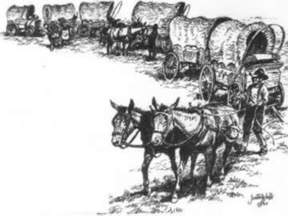 1844 was smaller than that of the previous season, but in 1845 it jumped to nearly 3,000. Migration to the West was here to stay and the trains became an annual event, although the practice of traveling in giant convoys of wagons soon changed to many smaller bands of one or two-dozen wagons. The wagon trains really became a thing of the past in 1884, when the Union Pacific constructed a railway along the route.
1844 was smaller than that of the previous season, but in 1845 it jumped to nearly 3,000. Migration to the West was here to stay and the trains became an annual event, although the practice of traveling in giant convoys of wagons soon changed to many smaller bands of one or two-dozen wagons. The wagon trains really became a thing of the past in 1884, when the Union Pacific constructed a railway along the route.
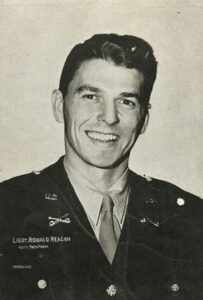
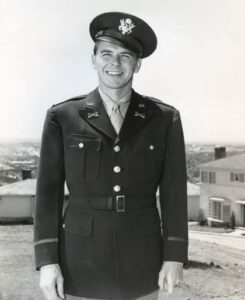 It’s almost unheard of to have a cavalry officer suddenly completely move in a different direction, and become an Army Air Force officer, but on May 15, 1942, Lieutenant Ronald Reagan, who had enlisted in the Army in 1935, was a cavalry officer at the time, applied for reassignment to the Army Air Force. Switching from the Army to the Army Air Force, while not unheard of, was an unusual event, especially in that no one really expected to be in the service for an extended period of time. For the most part, during World War II, it had been agreed upon that the soldier would be returned to the United States by February 1946. That said, it didn’t always make sense to make such a big move as switching branches of service.
It’s almost unheard of to have a cavalry officer suddenly completely move in a different direction, and become an Army Air Force officer, but on May 15, 1942, Lieutenant Ronald Reagan, who had enlisted in the Army in 1935, was a cavalry officer at the time, applied for reassignment to the Army Air Force. Switching from the Army to the Army Air Force, while not unheard of, was an unusual event, especially in that no one really expected to be in the service for an extended period of time. For the most part, during World War II, it had been agreed upon that the soldier would be returned to the United States by February 1946. That said, it didn’t always make sense to make such a big move as switching branches of service.
Then Lieutenant Ronald Reagan was, at least at that time, mostly looking to have a career in acting, and it was here that he would eventually put his thespian background to use making World War II propaganda films. Once his transfer was approved on June 9, 1942, Reagan was given a job as a public relations officer for the First Motion Picture Unit. The First Motion Picture Unit (FMPU) produced military training, morale, and propaganda films to aid the war effort. FMPU released Frank Capra’s “Why We Fight” series and a documentary of the bomber Memphis Belle, the crew of which completed a standard-setting 25 bombing missions in Europe for the first time. No other plane and crew, to that date, had managed to fly the 25 missions and make it back. War was a dangerous lifestyle for the Allied planes. The films were screened on domestic training grounds and in troop camps overseas as well as in movie theaters at home. The Memphis Belle documentary gave people hope that it could be done, and all was not lost.
Reagan did several other films, one of which, “Air Force,” which was later renamed “Beyond the Line of Duty.” That movie told the true story of the heroic feats of aviator Shorty Wheliss and his crew. Reagan narrated the film. While the documentary was originally intended simply to promote investment in war bonds, it won an 
 Academy Award in 1943 for best short subject. Reagan went on to narrate or star in three more shorts for FMPU including “For God and Country,” “Cadet Classification,” and “The Rear Gunner.” Reagan also appeared as Johnny Jones in the 1943 full-length musical film This is the Army. Of course, as we all know, Ronald Reagan’s true destiny was to become one of our greatest presidents of all time and a very brave man.
Academy Award in 1943 for best short subject. Reagan went on to narrate or star in three more shorts for FMPU including “For God and Country,” “Cadet Classification,” and “The Rear Gunner.” Reagan also appeared as Johnny Jones in the 1943 full-length musical film This is the Army. Of course, as we all know, Ronald Reagan’s true destiny was to become one of our greatest presidents of all time and a very brave man.
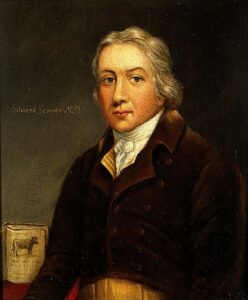 When we think of vaccinations, most of us think of modern-day medicine, but that wasn’t always the case. There have been serious diseases out there for centuries, and in fact, since Biblical days. Many of those diseases have been cured these days, or they are at least manageable, but in the 1700s, a disease like Smallpox was deadly. Others like Leprosy were just as bad. I’m sure that any doctor in those days cringed at having to make a diagnosis like that, because he knew that he was pronouncing a death sentence on his patient, and basically all he could do was to tell them to get their affairs in order and go into hiding to die, because their case was one with no hope of survival.
When we think of vaccinations, most of us think of modern-day medicine, but that wasn’t always the case. There have been serious diseases out there for centuries, and in fact, since Biblical days. Many of those diseases have been cured these days, or they are at least manageable, but in the 1700s, a disease like Smallpox was deadly. Others like Leprosy were just as bad. I’m sure that any doctor in those days cringed at having to make a diagnosis like that, because he knew that he was pronouncing a death sentence on his patient, and basically all he could do was to tell them to get their affairs in order and go into hiding to die, because their case was one with no hope of survival.
Vaccinations, for any disease, start out as trial and error, and Smallpox was no exception to that rule, but Edward Jenner, while still a medical student noticed that milkmaids who had contracted a disease called cowpox, which caused blistering on cow’s udders, did not catch smallpox. Unlike smallpox, which caused severe skin eruptions and dangerous fevers in humans, cowpox led to few ill symptoms in these women. I guess it takes a 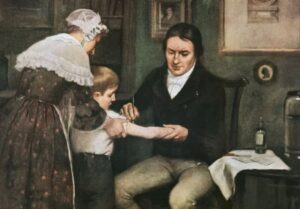 medically trained mind to connect the two situations and find whatever small similarity there is between the two diseases…and then decide to experiment with a possibility that no one else saw…or to decide not to.
medically trained mind to connect the two situations and find whatever small similarity there is between the two diseases…and then decide to experiment with a possibility that no one else saw…or to decide not to.
Jenner was that kind of a medical mind. By 1796, Jenner was an English country doctor, who hailed from Gloucestershire. On May 14, 1796, he took fluid from a cowpox blister and scratched it into the skin of James Phipps, an eight-year-old boy. A single blister rose up on the spot, but James soon recovered. On July 1, Jenner inoculated the boy again, this time with smallpox matter, and amazingly, no disease developed. The vaccine was a success. The medical world at the time, went wild. Doctors all over Europe soon adopted Jenner’s innovative technique, leading to a drastic decline in new sufferers of the devastating  disease, as well as many lives saved.
disease, as well as many lives saved.
Following Jenner’s model, scientists in the 19th and 20th centuries, scientists developed new vaccines to fight numerous deadly diseases, among them polio, whooping cough, measles, tetanus, yellow fever, typhus, and hepatitis B. The lists of vaccines, goes on and on, all using the same model. More sophisticated smallpox vaccines were also developed and by 1970 international vaccination programs, such as those undertaken by the World Health Organization, had eliminated smallpox worldwide. Many people, these days would question the World Health Organization, and its motives, but there was a time that vaccines were very helpful and saved a lot of lives. I think it is sad that politics has made its entrance into the world of vaccines, because the lack of trust we have now is making the World Health Organization more of a hindrance than a help.

 Working in a fast-food restaurant is often how someone gets started in a career in the culinary arts. Of course, that is how lots of kids get started in the work world too. My niece, Andrea Beach is an excellent cook and baker, and she really wanted to be a chef and even wanted to go to Culinary School, but like many people with that dream, she later became discontented with that line of work. Once you have been around restaurant life, you know that you will be working long hours, late at night, for people who are seldom satisfied, and somehow always think it is the fault of the chef. You might think I am talking about a chef that isn’t very good at his or her job, but I’m not. That is how it is for every chef or cook I know. People go out for a meal, and they somehow seem to think that if they don’t complain about the meal, they aren’t sophisticated enough…and I’m very serious about that.
Working in a fast-food restaurant is often how someone gets started in a career in the culinary arts. Of course, that is how lots of kids get started in the work world too. My niece, Andrea Beach is an excellent cook and baker, and she really wanted to be a chef and even wanted to go to Culinary School, but like many people with that dream, she later became discontented with that line of work. Once you have been around restaurant life, you know that you will be working long hours, late at night, for people who are seldom satisfied, and somehow always think it is the fault of the chef. You might think I am talking about a chef that isn’t very good at his or her job, but I’m not. That is how it is for every chef or cook I know. People go out for a meal, and they somehow seem to think that if they don’t complain about the meal, they aren’t sophisticated enough…and I’m very serious about that.
This was the world Andrea found herself, and she suddenly knew that it was time for a change. So, this single mom took a leap of faith and switched careers. Now she works at Ace Hardware. This was a career move sent to Andrea by God…literally. She loves her job, and her stress levels have dropped dramatically. The hours are better, which has made it possible for her to spend more time with her son, Topher who is a junior in high school. That last year of high school is so important to a student, and Topher is such a good kid. He and his mom ae best friends. She loves that the hours are better, as is the lower stress atmosphere.
Now that Andrea’s stepdad, Mike Reed is getting ready to retire, Andrea and Topher are looking at this being their last year in Rawlins. Now that her mom, Caryl Reed and Mike, are moving to Casper, Andrea is ready to start a new life in Casper as well. Andrea is listening to see what God has in store for her next. Planning a 
 move to a new city without a job or anything can be stressful, but Caryl and Mike have an apartment above their barn on the ranch they are moving to, so Andrea and Topher will have a place to live right away. Of course, a lot will depend on what Topher’s plans are for the next year too. College could take him a totally different direction, so time will tell. Nevertheless, Andrea knows that she wants to be in Casper, at least for the near future. After that…well, who knows. She is listening to hear Gods plans for her and Topher’s future. She loves the Lord and trusts in Him completely. In the very near future, Andrea is looking forward to the vacation trip to Montana and Yellowstone with her mom, Caryl and Topher. That should be a great time for all three of them. Today is Andrea’s birthday. Happy birthday Andrea!! Have a great day!! We love you!!
move to a new city without a job or anything can be stressful, but Caryl and Mike have an apartment above their barn on the ranch they are moving to, so Andrea and Topher will have a place to live right away. Of course, a lot will depend on what Topher’s plans are for the next year too. College could take him a totally different direction, so time will tell. Nevertheless, Andrea knows that she wants to be in Casper, at least for the near future. After that…well, who knows. She is listening to hear Gods plans for her and Topher’s future. She loves the Lord and trusts in Him completely. In the very near future, Andrea is looking forward to the vacation trip to Montana and Yellowstone with her mom, Caryl and Topher. That should be a great time for all three of them. Today is Andrea’s birthday. Happy birthday Andrea!! Have a great day!! We love you!!
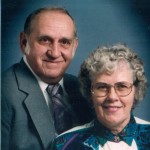
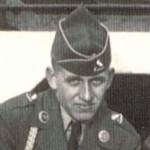 My uncle, Larry Byer was a really good musician, but that was not something I recall from years of hearing him play. It is something I’ve been told over the years. I never occurred to me that so many people in my family were talented musicians, but apparently there were a number of them. Uncle Larry played the guitar, the mandolin, and the piano. My grandfather, his dad, George Byer played the mandolin and the violin. My dad, Al Spencer and my Uncle George both played guitars. They had a regular band, and their jam sessions were like a big party at the Byer house. I knew that my dad, Al Spencer and his siblings were talented musicians, because I was told that over the years, but Uncle Larry is on my mom, Collene Spencer’s side of the family, and somehow, I just didn’t know. It’s possibly because by the time I was born, Uncle Larry was married, and starting a family of his own with his wife, Jeanette Morton. In fact, their son, Larry is just nine months younger than I am. These days, most of these band members are playing in Heaven, and I would sure love to hear that music.
My uncle, Larry Byer was a really good musician, but that was not something I recall from years of hearing him play. It is something I’ve been told over the years. I never occurred to me that so many people in my family were talented musicians, but apparently there were a number of them. Uncle Larry played the guitar, the mandolin, and the piano. My grandfather, his dad, George Byer played the mandolin and the violin. My dad, Al Spencer and my Uncle George both played guitars. They had a regular band, and their jam sessions were like a big party at the Byer house. I knew that my dad, Al Spencer and his siblings were talented musicians, because I was told that over the years, but Uncle Larry is on my mom, Collene Spencer’s side of the family, and somehow, I just didn’t know. It’s possibly because by the time I was born, Uncle Larry was married, and starting a family of his own with his wife, Jeanette Morton. In fact, their son, Larry is just nine months younger than I am. These days, most of these band members are playing in Heaven, and I would sure love to hear that music.
Uncle Larry was always a guy with a great sense of humor. He loved a good joke, and maybe that was what my Aunt Jeanette first saw in her husband of 55 years, before he went home to be with the Lord. Uncle Larry loved a good joke and wasn’t above pulling pranks either. I suppose he came by it honestly. I think just about everyone in my family…from both sides are tricksters and pranksters, and it had to come from somewhere, so I think there are a number of the aunts and uncles who had a hand in it. My mom was born between the two brothers in the family, and so she got a double portion of the pranks boys tend to play. Personally, I think she totally loved being the girl between the boys, because they included her in all the mischief.
Like all of my veteran loved ones, I am very proud that my Uncle Larry served in the Korean War. He didn’t talk much about his time in the service, but like most of the men of the war eras, he was proud to serve his 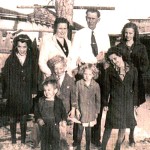
 country. Uncle Larry was an honorable man and an honorable soldier. After that he came home and started a family with his best friend and wife, Jeanette Morton. They married on February 11, 1956, and their first child, Larry was born on February 9, 1957. Tina followed on November 12, 1958. Uncle Larry worked for many years at Texaco Refinery, and when they closed down there, he transferred to Louisiana, until his retirement. Today would have been Uncle Larry’s 88th birthday. Happy birthday in Heaven, Uncle Larry. We love and miss you very much.
country. Uncle Larry was an honorable man and an honorable soldier. After that he came home and started a family with his best friend and wife, Jeanette Morton. They married on February 11, 1956, and their first child, Larry was born on February 9, 1957. Tina followed on November 12, 1958. Uncle Larry worked for many years at Texaco Refinery, and when they closed down there, he transferred to Louisiana, until his retirement. Today would have been Uncle Larry’s 88th birthday. Happy birthday in Heaven, Uncle Larry. We love and miss you very much.

